Contents
We live on an acreage with a clear view of the Canadian Rockies, and enjoy watching all kinds of animals. This is a short list of what we happen to see in and around our yard. Most of those we have positively identified, otherwise we use the (generic name).
Mammals -- Richardson's Ground Squirrels, (moles), (voles), (mice), Badger, Ermine, Muskrats, Snowshoe Hare, White-tailed Jack Rabbit, Coyotes, Mule Deer, White-tailed Deer, Moose.
Birds (long-legged waders) -- Great Blue Heron.
Birds (duck-like) -- Bufflehead, American Coot, Ruddy Duck, Common Goldeneye, Canada Goose, Eared Grebe, Mallard, Common Merganser, White Pelican, Lesser Scaup, Northern Shoveler, Blue-winged Teal, Cinnamon Teal, Green-winged Teal, American Wigeon.
Birds (sandpiper-like) -- American Avocet, Killdeer, Wilson's Phalarope, Common Snipe, Lesser Yellowlegs.
Birds (upland ground) -- Gray Partridge.
Birds (Chicken-like Marsh) -- Sora.
Birds (owls) -- Northern Hawk Owl.
Birds (hawk-like) -- Bald Eagle, Peregrine Falcon, Ferruginous Hawk, Red-tailed Hawk, Rough-legged Hawk, Swainson's Hawk, American Kestrel, Merlin.
Birds (swallow-like) -- Cliff Swallow, Tree Swallow.
Birds (tree-clinging) -- Common Flicker
Birds (hummingbirds) -- Rufous Hummingbird, Ruby-throated Hummingbird.
Birds (perching) -- Red-winged Blackbird, Yellow-headed Blackbird, Mountain Bluebird, Black-capped Chickadee, Brown-headed Cowbird, Common Crow, Gray-crowned Rosy Finch, House Finch, American Goldfinch, Pine Grosbeak, Blue Jay, Dark-eyed Junco, Eastern Kingbird, Black-billed Magpie, Western Meadowlark, Common Raven, American Robin, Northern Shrike, Chipping Sparrow, House Sparrow, Savannah Sparrow, White-crowned Sparrow, Starling, Cedar Waxwing.
Insects -- (mosquitoes), (flies), (spiders), (bees), (wasps), (butterflies).
Reptiles -- Northern Leopard Frog.
Domesticated -- (horses), (dogs), (cats).
Over time we will try to make pictures of them and publish those with a little blurb.
We use the following books to help us in identification and learn more about the wildlife in our area:
Several bird pictures were provided by Jo Penders, brother of my wife. On his visits to Canada he made lots of videos. Most of the pictures that has his name on it, were actually images copied from those videos. We enlarge them as much as we could, but obviously the quality is not as good as pictures taking directly with a digital camera.
Family: Squirrels (Sciuridae)
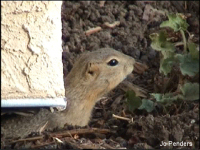
Cute animals, often standing erect on its hind legs surveying its surroundings. Because of that it is especially attracted to cut lawns. Multiply at an alarming rate if left unchecked. They are considered a pest on farmland, and are often referred to as gophers.
When we were building the house there were gophers everywhere. My wife thought they were cute. We moved in and the next year in spring there were four gopher dens on our property. The young ones came out and their parents were moving them around. My wife thought they were cute. My wife started a vegetable yard. Somewhere we had read that when you planted marigolds on the outside of the vegetable yard, that it would keep the gophers out. Next thing you know the gophers were having a feast eating lettuce. My wife thought they were cute, but not anymore. We had to surround our vegetable yard with mesh wire fencing and dig that into the ground.
The picture is of a very smart gopher which I have not been able to catch. Here he is peeking from under a deck support column.
Family: New World Rats and Mice (Cricetidae)
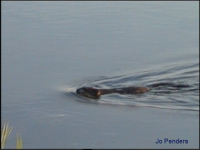
Pretty big suckers at 16 to 24 inches (40 to 60 cm). A common sight where there is water like in the pond on our property and the ponds in our neighbourhood. They are harmless creatures. Can often be found on the edge of our pond eating edge vegetation, or "carrying" fresh reed leaves to their den or larder.
The problem is that they dig into the embankment of the pond, making tunnels to where they create dens and larders under our lawn; sometimes as far as 6 to 8 meters from the pond edge. If you are not aware of this then you run the risk of having your foot suddenly "sinking" into the ground and possibly making you trip.
Family: Rabbits and Hares (Leporidae)
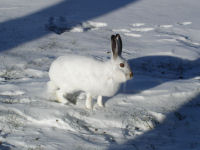
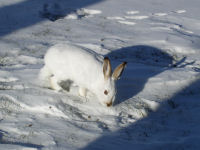
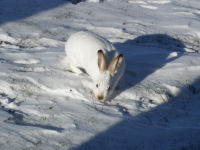
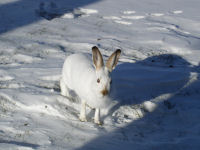
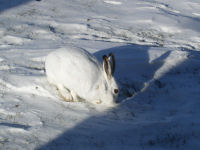
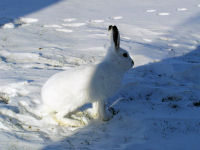
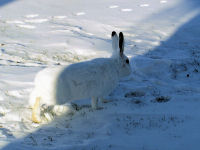
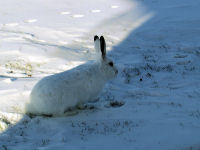
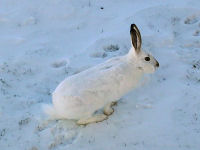
We came home from shopping and from the warmth of our house -- it was -15°C outside -- we checked on the Grey Partridges that were feeding and hiding in the snow down the hill.
When we looked down from our breakfast nook window there was the hare scraping away the snow and eating the old grass. It gradually moved more to the right and eventually settled next to the wishing well for a long afternoon siesta. It was only when it was almost dark that it continued feeding. After we switched on the light the snowshoe hare dashed away when we looked out through the window. We must have been a scary sight. For us it was the first sighting in the 12 years that we live here.
Family: Rabbits and Hares (Leporidae)
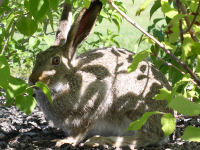
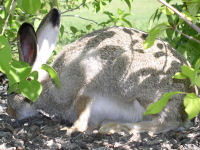
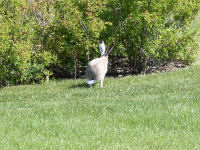
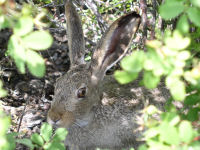
We have seen the Jack Rabbit since early August 2009, but it was each time to fast for a good close look. We were even wondering if it was perhaps the Snowshoe Hare from last winter. End of August I was mowing the lawn and the Jack Rabbit was hopping from a flowerbed with roses to a flowerbed with lilacs. I stopped the lawn mower and slowly walked to the flowerbed while softly talking to the rabbit. At 5 meters it still had not mowed away, so I back-tracked and got my camera. Repeated the approach, still no reaction, then I continued on hands and knees to get as close as 2 meters. To make the pictures I had to lay flat on my belly.
After that I tried to move to another position in the hope to get a better angle, but that was to close for comfort as far as the rabbit was concerned and the rabbit hopped back to the roses bushes. I still managed to make a few more pictures there. Later on I compared the pictures with the entries in the Audubon Society Field Guide to North American Mammals, and I found that the size of the hind legs, the overall colouring, the ears and the completely white tail made this positively the White-tailed Jack Rabbit. The funny part is that we have not seen the rabbit since the photo-op.
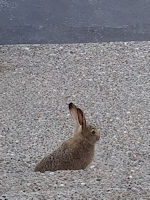
(May-2020) A bunny paid us a visit at our front door, going up and down the steps.
Family: Wolves, Foxes, and the Coyote (Canidae)
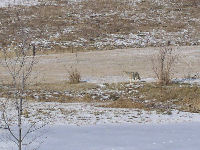
No a very good picture, but it will have to do until we get a better one. This coyote was on the other side of our frozen pond hunting for mice, but no luck as far as we could see. An hour later it was back again; this time harassing the three dogs of our neighbour. The coyotes have every year a den on the farm land West of us. They usually have 6 to 8 pups in spring, and most of the time we see them for several months.
Family: Deer (Cervidae)
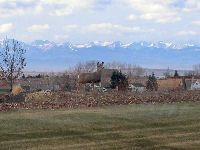
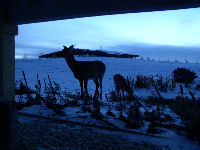
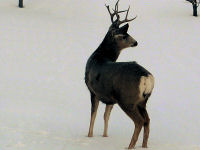
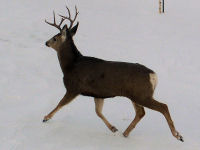
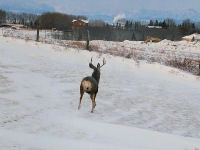
Around noon this mule deer suddenly showed up, but this time it stayed on our neighbours property and eventually dashed away together with its mate. In the winter we have seen plenty of wildlife tracks in the snow from coyotes, deer and even moose. While several people in our neighbourhood told us many stories about deer eating their bulb flowers, shrubs, and trees, we had never problems until two years ago.
That winter the deer did lots of damage to our American Mountain Ash and May Day trees. In spring the buds of our tulips were nibble off before they had a chance to flower. The end of that summer we had still some lettuce and a second late harvest of strawberries. We were just holding out as long as possible until the first frost. Well we waited too long. One morning all the lettuce heads were eaten, while the strawberries and leaves had served as dessert for one or more deer. Next year we lost the top of all our green peas.
The fence around the vegetable yard is only 2 feet high, and only intended to keep the gophers (Richardson Ground squirrels) at bay. As the deer "attacks" have gotten worse, we have decided to raise the fence around our vegetable yard. The fence will then be too high for us to step over, and a garden gate is needed. Hence the garden gate project.
Early December 2004, at dusk, we noticed a doe and fawn eating whatever green was left in one of our flowerbeds. I scare them away, but five minutes later I looked and now there were three having a meal at the same patch. And again, some 20 minutes later the first two were back. It is clear that the Dianthus Sweet William (perennial) we planted this year, is not the right choice for our area.
(Dec-2008) When I got up I saw a mule deer buck on our driveway and a doe on the road. The doe walked further away while the buck was undecided what to do next. After about 5 minutes the buck turned and walked towards the house with the intend to pass by on the North side. I walked to the kitchen and then I saw the buck walking further downhill towards the poplars around the pound. It so happened that there was a covey of Grey Partridges feeding and snoozing in the snow there. The buck put his nose between them, but they hardly moved a foot away. In the end the buck "scented" (marked) the area.
Family: Deer (Cervidae)
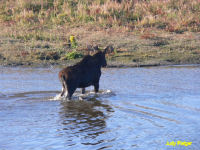
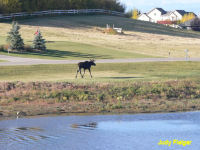
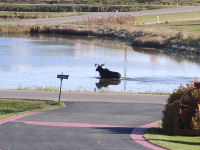
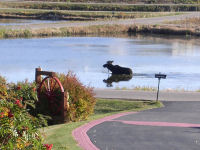
From time to time we see moose in our area. The first year we lived in the country side a friend saw two "horses" galloping on the farm land behind us with snow reaching up to their bellies. On closer inspection through the binoculars it turned out to be a cow moose with her calf. It was an awesome sight to see how effortless they ran through the thick snow, and since then I have an enormous respect for those animals and keep my distance.
(1-Oct-2008) This summer we had visitors and were sitting in our breakfast corner, when suddenly a bull moose walked along the North side of our pond. Later on that day he crossed our land again and then decided to wade through the pond across the street. He did the same at the pond of a neighbour further down the street. And that resulted in some nice pictures.
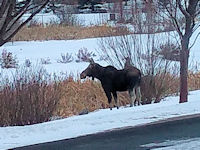
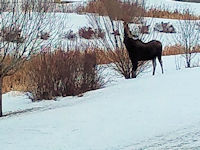
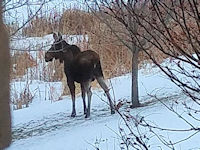
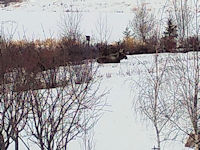
(Jan-2020) A cow moose and her calf surprised us with a visit.
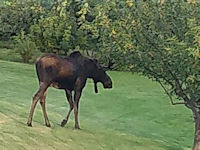
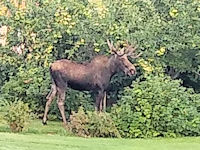
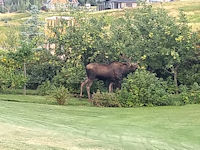
(Aug-2020) A bull moose robbed us from half the apples of a tree in our orchard.
Family: Herons (Ardeidae)
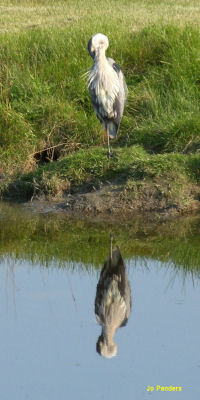
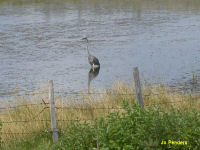
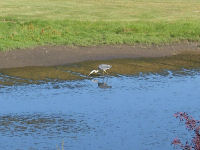
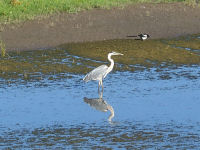
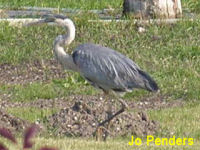
Large, graceful flier. Can stand a long time still without moving a "feather", and then strikes out at its prey almost elegantly. We have seen it eating salamanders and mice. There is no fish in our 2 feet deep pond!
Family: Rails (Rallidae)

Here you see mom with her two young ones which we saw growing up. We always laugh at the way they walk when they come on land; they look like an old man bended forward, with his hands on his back and walking fast as if ready to topple over.
Family: Ducks (Anatidae)
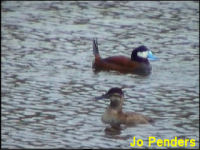
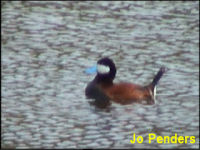
The Ruddy Duck is very easy to recognize with its light blue bill. One of favourite ducks, because when they are displaying tthey bob their head up and down, and that looks so comical.
Family: Ducks (Anatidae)
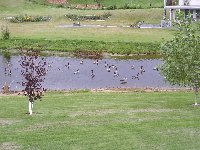
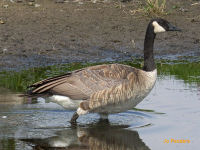
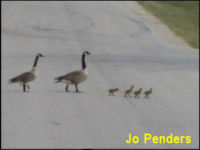
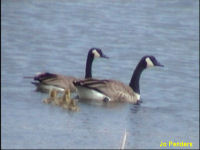
We were having dinner when suddenly a gaggle of geese landed in our seasonal pond. We counted 42 of them. They stayed for about 2 hours splashing in the water and grooming themselves. And what a splendid sight it was when they all took off together.
Canada Geese return every year to our area. Several couples end up with up to seven goslings. When the mating season start the adults are fighting each other, but once the goslings are there it is one big happy family. You should see the "fertilizer" they leave behind everywhere.
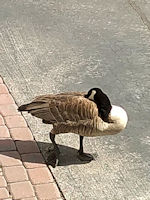
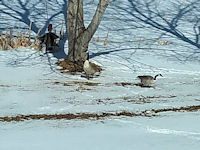
(Apr-2019) An early arrival found a nice warm spot on our driveway just before the steps to our front door.
(Apr-2020) Again an early arrival of a couple. Note the snow on the ground and frozen pond behind the tree truck.
Family: Grebes (Podicipedidae)

This grebe is easy to identify. That is why it is so easy to spot when it accidentally lands in one of the ponds in our sub-division. Yes, I cheated once more. This picture was not taken on our property, but in Fishcreek Park in the South of Calgary.
Family: Ducks (Anatidae)
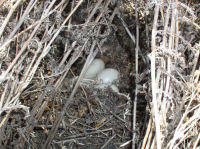
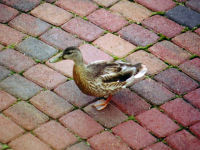
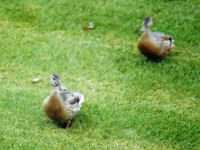
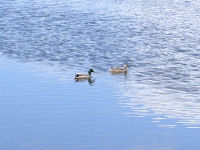
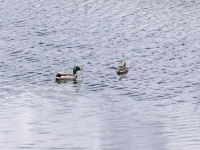
(2-May-2005) The female mallard have been walking around our property for days, and sat several times on our front steps, much to the delight of our cats. Today I was cleaning our main flowerbed (top tier, South West) when our cat Softie walked into the old growth of the Yarrow. Next a mallard flew out of it. A closer look revealed a mallard's nest with four eggs. I cleaned the rest of the flowerbed, but left the old growth of Yarrow. It will look bad, but it is for a good cause. Wonder when we should give the baby shower. Sure enough the mallard layed three more eggs and then went on "holidays". It was in the pond and ventured out onto our other neighbour's property, but never sat on the eggs.
(8-Jun-2005) We left the nest untouched until today. The past week we did seen a Common Crow sitting on the model windmill that is about four meters away from the nest. Today we actually saw the crow feasting on an egg. Later on the crow came back to have another bite or two.
Family: Ducks (Anatidae)
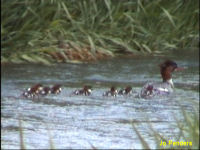
A rare sight on the ponds in our sub-division, but we have seen it. This picture was taken in Fishcreek Park in the South of Calgary.
Family: Ducks (Anatidae)
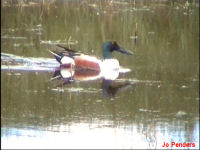
The male looks a bit like the Mallard, but when you see a large duck skimming the top of the water with his large wide shovel-like bill then that is the Northern Shoveler. A common sight in our pond.
Family: Ducks (Anatidae)
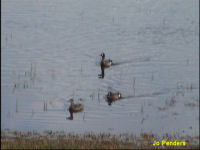
Teals were a common sight in our pond, and so is the Blue-winged Teal. However, after about 2012 they are far less common.
Family: Plovers (Charadriidae)
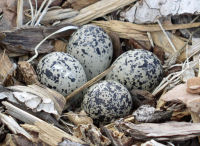
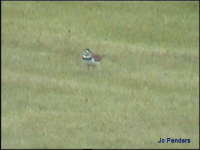
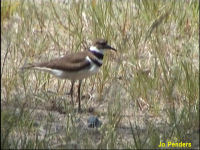
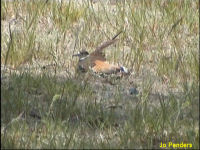
(15-May-2006) I was mowing the lawn when I discovered a Killdeer leaving the mulch under one of our Saskatoon Berry shrubs. On closer inspection I found a nest with four greenish eggs with black speckles. The eggs are a little over 1 inch long (2.5 cm). From the house we were spying on them through our binoculars and after dinner I noticed that the parents were not on the nest so I grabbed my camera and made some pictures of the eggs. As I was making the picture one of the parents showed up, making a hell of a noise pretending that it was badly wounded by hobbling and dragging its wings. When I walked towards it with the intension to make a picture of the bird, it each time went away a bit further and in that way getting me away from the nest. The bird kept doing that until we were almost at the house and then it flew away. I have seen this behaviour many times before, but each time it fascinates me again.
(28-May-2006) When watching for the killdeers on this rainy day I found the nest empty. Sudden I caught some movement through the binoculars and saw both parents and two of their offspring. The search was on, and after half an hour we spotted all four youngsters. They are an exact carbon copy of their parents. The grass needed mowing and the little ones keep tripping over the tall grass. They stayed mostly on the bark cover under the trees and shrubs. The next day I had to mow the lawn, and sure enough they were smack in the middle of it. Luckily the parents warned me, so I stopped the riding mower, and after a while their tiny heads poked up through the tall grass. Later on the whole family moved and spent the afternoon on the edge of our pond.
(2-Jun-2006) The killdeer family is back again. The four youngsters are doing well. They walked up the gardenpath past the front window and over the driveway. We had a nice close look. Their wing feathers are not yet developed. The tip of their tail feathers are downy curls.
(Jun-2012) This year the Killdeer family made another nest with 4 eggs in the mulch under the raspberries shrubs.
Family: Phalaropes (Phalaropodidae)
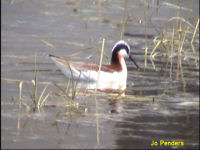
While the Killdeer are seen throughout the whole season, the phalaropes prefer our pond when it is just a bit dried up and has a nice edge of mud. That is the domain that most of the sandpiper-like birds enjoy.
Family: Sandpipers (Scolopacidae)
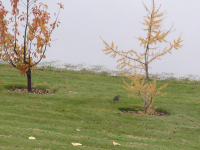
Used to be a common sight around the edges of our seasonal pond. Difficult to get up close to for a good picture. Since around 2012 we haven't seen them anymore.
Family: Sandpipers (Scolopacidae)
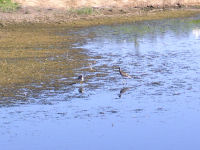
A member of the Sandpiper family. Our shallow seasonal pond fills up after the winter when the snow melt and the spring rain in May and June. In August the water evaporates creating the ideal environment along the edges for these types of birds.
Family: Pheasants (Phasianidae)
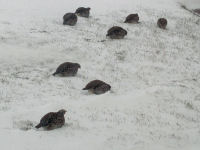
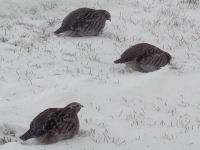
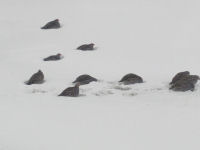
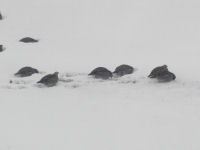
We see them two or three times a year in coveys of 6 to 10. They stay mostly in flowerbeds under the shrubs, are very skittish and up till now we were never able to make a picture of them. However, this time the land was covered in 15 to 20 cm of fresh snow while the temperature was around -20 C (-4 F). There was quite some wind and it was still snowing. We noticed six dark forms at the bottom of the slope. We first thought that the musk rats had come out of their den, but it turned out that it were 6 gray partridges. After a while they flew towards the house and landed under our kitchen window in the deep fluffy snow.
As we were watching, I caught movement through the other window, and sure enough there were 4 more partridges that joined the others making a covey of 10. From a basement window I was able to make a good picture of them while they were scratching the snow away with their legs and then ate the grass. After half an hour they went further down the hill and I made a few more pictures, but those are not to good because of the falling snow.
Family: Owls (Strigidae)
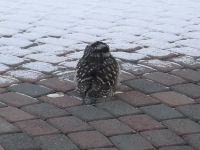
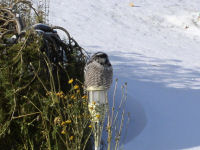
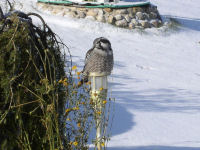
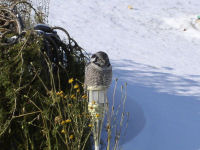
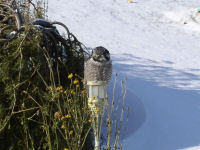
On the eve before the Canadian Thanksgiving Day (11-Oct-2009) we had a great turkey dinner with our 5 guests. After the main course we decided to watch a movie and have desserts about halfway through. Suddenly there was a very loud bang. After our first shock we checked all the rooms and checked outside -- as far as that is possible in the dark -- what could have caused that, but we did not find anything.
The next morning I solved the "big bang mystery". When I opened the curtains downstairs there was an owl sitting on the patio just under the North edge of the deck. From the amount of droppings it was obvious that the owl had been there a long time. My conclusion was that the owl flew into a glass panel of the deck railing and just dropped on the patio. It turned its head around when I opened the door, but that was about it. While I was searching for the phone number of the Alberta Institute for Wildlife Conservation (AIWC) in Madden, the owl got pestered by 5 magpies and it moved somehow to one of those led lights we have in the flowerbed a few meters from where it sat first, but there the owl remained no matter what the magpies did.
About an hour later a AIWC volunteer from Airdrie came. He identified it as a Northern Hawk Owl. As he tried to catch the owl it flew to a post of the back fence. There he was able to catch it with a net. The owl might have some concussion of some sort as the owl did not made any attempt to get away when approached the second time, and the volunteer observed also that its left eye did not work properly. If everything goes okay they will release the "resident" owl back into the wild on our land hopefully in about a week.
On 23-Oct-2009 the Northern Hawk Owl was released again on our property in the exact spot where it was captured. Unfortunately we were not home to witness this event while the director of the AIWC felt that they could no longer wait as the owl was becoming very upset in captivity.
We find positive identification of raptors quite difficult, at least for the amateur. Male, female and juvenile have often different markings. Some species have different phases, while other species show regional differences. It is often a matter of elimination rather than identification. Please accept our apologies for possible misidentification, and send us an e-mail with the correct species name.
Family: Falcons (Falconidae)
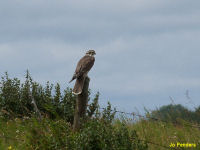
My brother-in-law, Jo, captured this falcon with his new digital camera, while it sat on a fence post in our backyard.
Family: Hawks (Accipitridae)
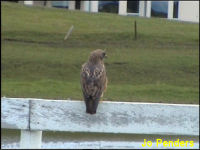
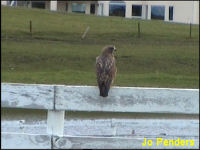
A front, side and rear view pictures would help a lot in the identification. And so does high resolution pictures.
Family: Falcons (Falconidae)
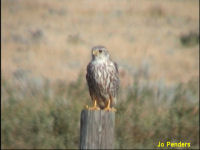
A merlin is also called a "pigeon hawk", because of its flight pattern and its size. In the olden days we had to deal with pictures in reference books. Nowadays web sites like from Cornell Lab of Ornithology are a huge help.
Family: Swallows (Hirundinidae)
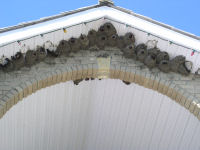
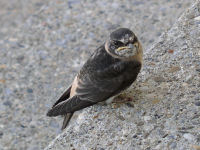
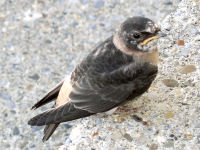
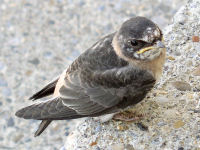
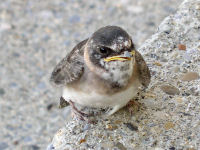
We like birds and, with all the water around us, swallows are very important to keep the mosquitos under control. They use our house to build their nests against. Peaked awning is their favorite spot, but they build really at any spot around the house against our yellow stucco. Cute? Yes, but the problem is that it is not one or two nests, but a whole colony of some 50 to 60 nests every year. You should see the mud mess under their nests on our steps and against the windows. Also four picture of a cliff swallow young resting on our steps.
In 2006 we put netting under the eaves around the whole house to create a physical exclusion of these swallows. You can read background information and how to do that in Swallow Control, Agdex 685-7. We also have Tree Swallows (Iridoprocne bicolour) on our property. Much less of a problem, but they occupy the nest boxes that are intended for the Mountain Bluebirds.
Family: Swallows (Hirundinidae)
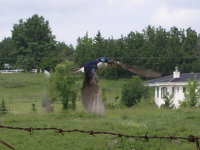
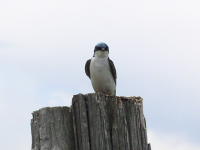
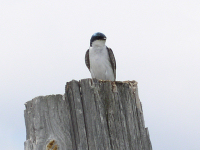
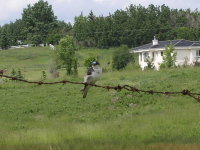
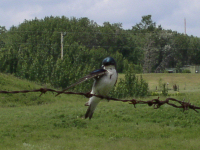
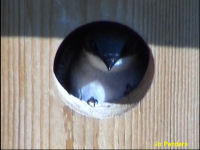
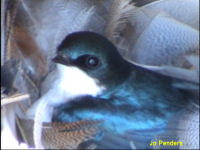
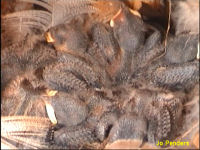
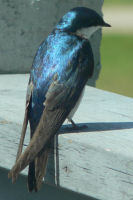 Courtesy Jacquie Tummers.
Courtesy Jacquie Tummers.
Swallows are very important to keep the insects under control. Apparently one swallow eat up 800 insects a day. That is one reason that all swallows are internationally protected.
We have two nest boxes placed on the fence posts along the back of our property. The boxes were intended for the Mountain Bluebirds. Right from the beginning the Tree Swallows have occupied them. This year (2006) we have put the two nest boxes further apart and sure enough, one box is now used throughout the spring by Mountain Bluebirds and the other by the Tree Swallows. When we work in our orchard the swallows sit on the barbwire fence close to the nestbox with hedged youngsters, and that is how we were able to make these pictures. The first picture is a swallow coming in for a landing. Just a lucky shot I guess.
Family: Woodpeckers (Picidae)
We see the common flicker often in the parks around Calgary. This year I had lunch at my friends' house when there was a hammering sound. My friend had heard it alreay for a few days, but had no clue what that was. When we heard it the second time I said that sounds like a woodpecker. And sure enough, when we went outside we saw a common flicker on top of an airvent.
We find positive identification of hummingbirds quite difficult, at least for the amateur. They are moving very quickly, hovering in one spot for only seconds, and only sit still for a moment if they like your hummingbird feeder. Please accept our apologies for possible misidentification, and send us an e-mail with the correct species name.
Family: Hummingbirds (Trochilidae)
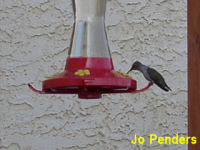
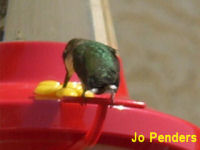
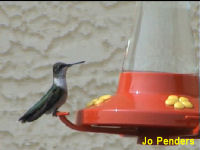
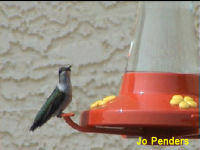
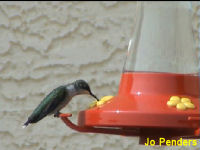
This year (2006) we have lived in this location 10 years. Only once I have seen a hummingbird on our Maltesse Cross perennials in our flowerbed. Jo Penders, brother of my wife, comes here on vacation and within days he sees them regularly, records them on video and make photographs of them. Okay, he also breeds exotic birds in captivity, and has done that his entire life. In other words, he is much more than just an amateur like me. Enjoy the results of his work.
Family: Orioles (Icteridae)
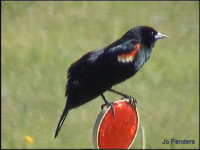
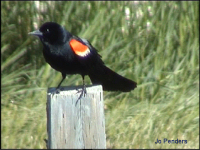
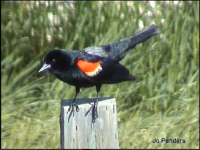
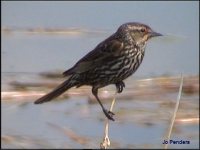
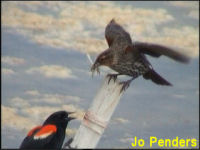
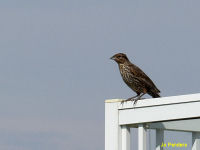
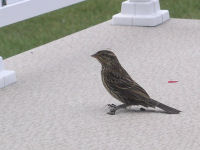
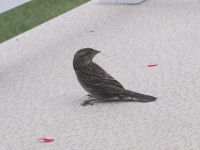
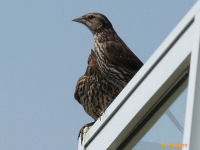
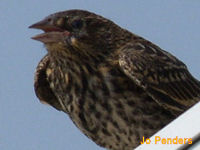
The Red-winged Blackbird is a member of the Orioles family. They build their nest on the edges of the ponds in reed and bulrushes. They have a loud voice that is very distinctive, as is their red and white "sergeant" stripe on each wing. When they come in on a glide path to land, those red patches are very well visible and is one of my favourite sights. The sunflower seeds in our bird feeder is highly appreciated.
The spotted bird is the female, but the immature birds look also like the female. The juveniles can be recognized by their behavour, like begging for food.
Family: Orioles (Icteridae)
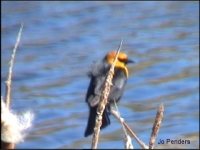
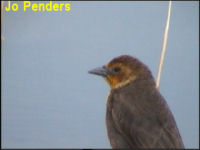
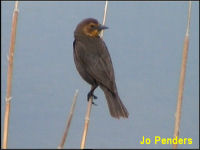
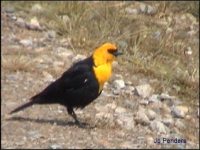
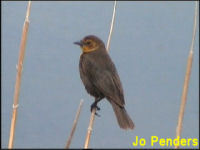
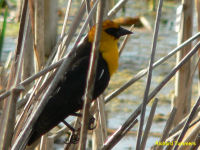
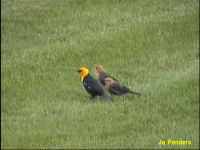
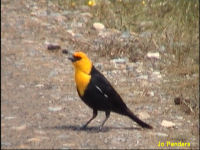
The Yellow-headed Blackbird is also a member of the Orioles family. They build their nest on the edges of the ponds in reed and bulrushes. They have also a loud voice that is completely different from that of the Red-winged Blackbird. Their white wing patches are very clear in flight. When they come in on a glide path to land, those white patches are very well visible and is one of my favourite sights. The sunflower seeds in our bird feeder is highly appreciated.
When they are threatened by predators the Yellow-headed and Red-wing Blackbirds join force to defend their territory.
Family: Thrushes (Turdidae)
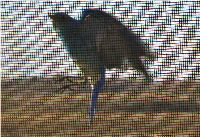
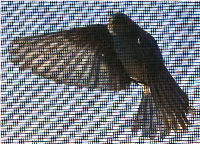
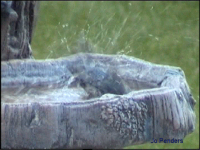
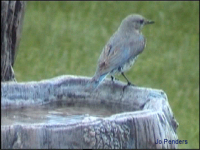
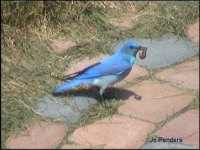
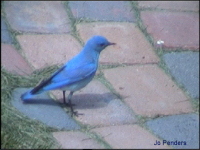
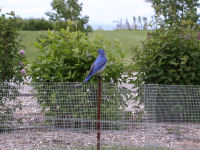
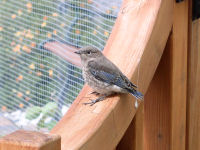
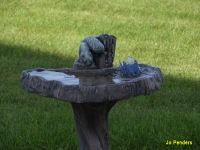
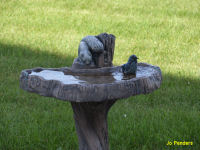
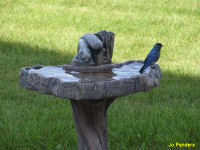
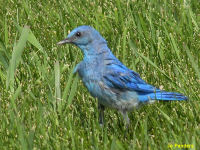
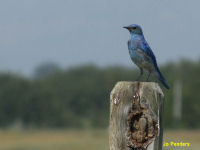
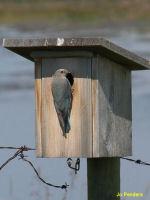
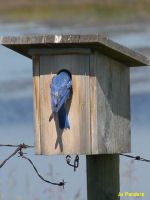
(24-Mar-2004) I was in my office in the basement when there was a tapping sound on my window. I opened the blinds to look -- I suspected that it was my wife -- and right then a male Mountain Blue Bird flew up to the window tapped on it and flew away to rest on the wishing well. Next the female Mountain Blue Bird did the same. Then I saw them doing the same at the other windows on that side of the house. We suspect that they where attacking their own reflection in the window as there were no insects at all.
It took me a while to recover from my surprise though, but then I went upstairs to tell my wife. We both enjoyed their performances. Finally my mind got working again and I dashed downstairs, grab my digital camera and positioned myself at the window. I made the above two lousy shots, when I realized that the screen was still in front of the window, and then... the batteries where empty. Arrggghhhh.
The female is less colourful and is more grayish, while the male is beautiful blue. Juveniles are grayish-brown with only a shine of blue.
Taking a bath is all part of the daily routine. When you see a bird hovering absolutely still some 6 to 8 feet above the lawn then that is for sure a Mountain Bluebird looking for insects.
Family: Titmice (Paridae)
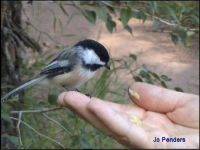
A member of the Titmice family. A very active little bird which we often only see in a flash. Their rapid "chicadee-dee-dee" song is unique.
Okay, so I cheated. This picture was not taken on our property, but in Fishcreek Park in the South of Calgary.
Family: Orioles (Icteridae)
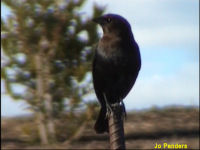
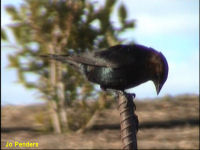
I always have to look twice before I realize that it is the brown-headed cowbird. It is smaller than the Red-winged Blackbird, the Yellow-headed Blackbird and the Magpie.
Family: Finches (Fringillidae)
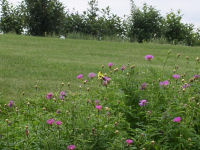
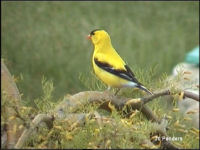
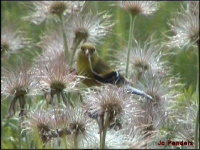
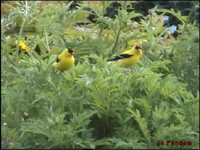
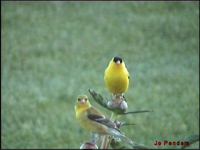
Southern Alberta is its Northern most range. We have seen them flying by in a flash for many years, but since we planted corn flowers they take the time to eat, and that gives us the time to watch and make a picture.
Family: Finches (Fringillidae)
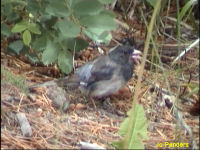
The picture here was not taken on our property, but is indeed the Dark-eyed Junco. The bird that we do see from time to time on our property is the Slate-coloured Junco. These are dark slate gray on head, upper breast, flanks and upper parts. Their tail is dark gray with white outer tail feathers. Belly and lower breast are white. Their bill is pink. We see these juncos often together with the House Sparrows.
Family: Crows (Corvidae)
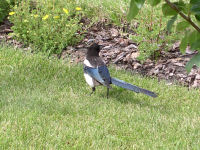
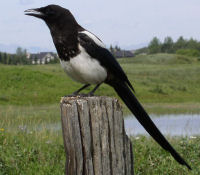
A noisy, daring bird often seen in groups of two or three or in company of common crows. They eat rodents and dead gophers, and complete their meal with some berries from our orchard. In the proper light their long black tail can have a beautiful dark green-blueish sheen.
(12-Oct-2006) Around dinner time there were three magpies in our yard. We thought that one had a reddish sheen on its normally white breast. And sure enough through the binoculars we could see that it had lots of pink-reddish feathers on its breast and belly. On its back the normal green-blueish sheen was now a rusty kind of gloss. When the magpie flew away the normal white wing ends were brown-reddish. A very unique sighting. I remember seeing a magpie in our backyard some 6 or 7 years ago that had all pale red feathers instead of the normal white ones. When you see it for the first time you cannot believe your own eyes.
Family: Orioles (Icteridae)
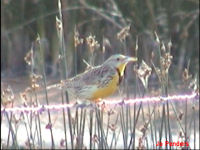
Unfortunately, we don't see this bird very often. Actually, you often hear it well before you see it. One day I was working in the back yard picking thistles from our lawn, when a meadowlark sat on a fence post. I just sat on the lawn for at least 15 minutes listening to its songs. Just a day I will never forget.
This picture was not taken on our property though.
Family: Thrushes (Turdidae)
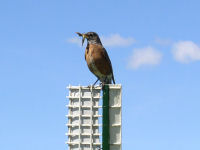
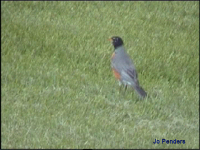
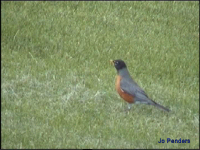
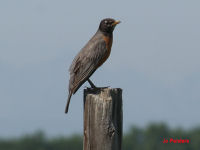
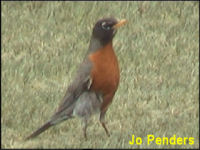
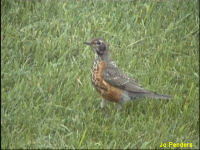
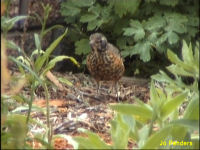
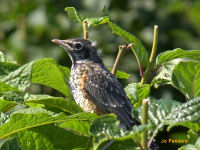
The robins with the brown spots on their breast are the juveniles.
The robin, a member of the thrush family, is a common sight in our yard. When I am mowing the lawn there are always a few walking around looking for a juicy morsel to eat. Here a robin is sitting on top of a vane of our model windmill.
Family: Finches (Fringillidae)
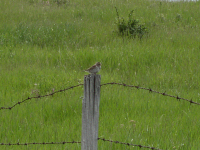
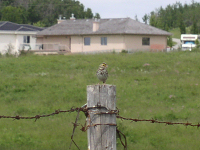
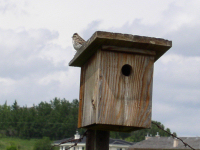
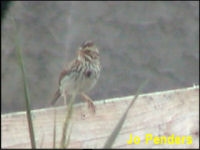
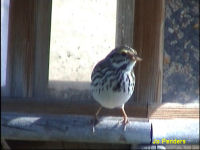
My friendship with Savannah Sparrows dates back from when we moved onto our acreage. I was paving patios and paths around the house laying some 10,000 bricks by hand. Hundreds of hours sitting on my knees and pounding in the bricks gave me plenty of opportunity to listen to what goes on around me. The song of the Savannah Sparrow is a series of high-pitched chips and trills that start slowly and ends in a rapid slur. Then when you look you see a sparrow with a yellowish arch above the eyes. When we go to our orchard in the back of the yard they are there in no time flat, sitting on the fence posts. They nest on the ground, and we had a nest in the edge of a well around a tree.
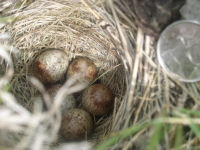
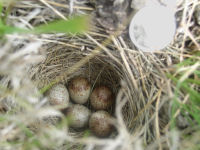
(4-Jul-2008) Got even more appreciation for my little friends. We have three long rows with fruit shrubs and trees. The rows are covered with cedar bark. I was mowing the grass between the rows when suddenly a savannah sparrow dashed out from the edge of a row, less than 2 feet (60 cm) in front of the riding mower. Sure enough there was a small grass lined nest with 5 blue-green eggs, spotted and speckled with dark brown. The nest was further hidden by overhanging tall grass and close by a raspberry bush. In the meantime the male savannah sparrow sat singing on a nearby fence post, while the female circled around me in the hope to attract my attention away from the nest. She even used the lame wing display like the killdeer do. I got out of the way quickly. Next week same thing happened when I was mowing there and the 5 eggs were still there. Today, 2 weeks after I saw the nest for the first time, I had to mow again, but this time I took my digital camera with me and had it ready for close-up picture taking.
The round thing in the top right corner is a Canadian quarter as a size reference with a diameter of 24 mm (15/16"). I calculated the eggs to be 13 by 15 mm (1/2 by 19/32").
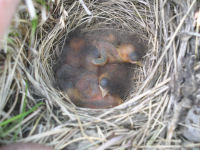
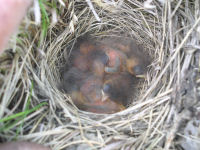
(7-Jul-2008) I was curious how the eggs were as there are lots of scavengers around like crows and magpies. Surprise, surprise, all the eggs have hatched and the parents kept away as much as they could. Today (the 8th) they are still doing fine after a bad thunderstorm last night with heavy rain and big hail.
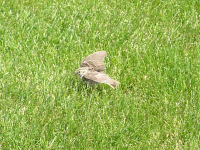
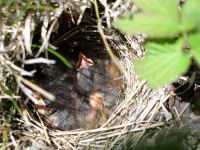
(9-Jul-2008) As soon as I approached the nest the female savannah sparrow dashed away from the nest and immediately started her lame wing display. The youngsters reacted to me making noise by opening their beaks. I only counted 4 of them, but I did not want to disturb them too much. Will have to do another check in a few days.
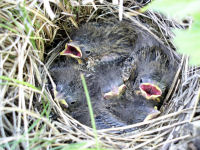
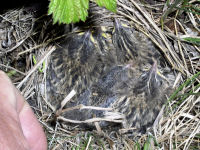
Pictures made on 12-Jul-2008 and 14-Jul-2008. The five youngsters are growing well. On the last picture the colours in the feathers become visible. Mom and dad are getting used to me when I quickly go to the nest to make a few pictures. What I also noticed in the last 2 or 3 days is that there are up to 4 adults close by on the fence or in the bushes, as if there is an aunt and uncle helping out with the feeding.
On 16-Jul-2008 the nest was empty. Incredible, less than 12 days from eggs to fledging. Only saw the parents who were clearly warning the youngsters, but I could not locate them. The next day my wife noticed lots of little birds in the back of the yard and sure enough there were lots of savannah sparrows hopping around. In the afternoon I was mowing the lawn and the youngsters were everywhere. They are slightly darker than their parents, and were somewhat clumpsy in their efforts to find insects. What really gave them away was that they did not fly very far, and they were clearly not afriad of the lawn mower as they walk right in front if it. I am quite proud being able to record all this.
Family: Finches (Fringillidae)
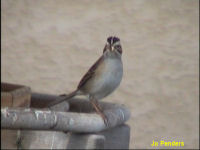
We have hundreds of House Sparrows around the house, but in order to see a Savanah Sparrow or a White-crowned Sparrow you have to pay attention, otherwise you think that it is just another House Sparrow.
Family: Waxwings (Bombycillidae)
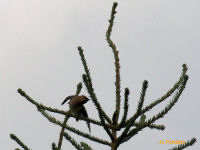
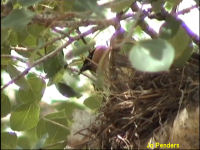
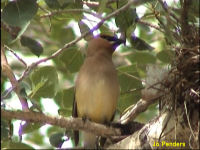
From time to time a group of Cedar Waxwings descend on a shrub or tree with berries in our yard. They eat their fill within a few minutes and are gone again. We have seen them also often in Big Hill Springs Provincial Park, just North of Cochrane in Alberta. These pictures where actually taken there.
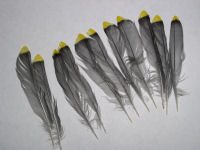
One day I had just mowed the lawn when I walked passed the Shubert Chokecherries. One cedar waxwing had been indulging too much on the berries and forgotten to watch out for predators. All I found was a bunch of feathers, including these tail feathers with the distinctive yellow tip.
t.b.d.
Family: ??? (???)
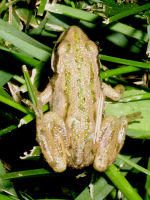
These frogs are very common on our land. In spring they can make a hell of a noise. I like it, but it keeps my wife awake at night when the bedroom window is open. In the summer they are absolutely silent, and can be found in the wells around our trees and shrubs which are 2 to 3 meters away from our seasonal pond. Their body is barely one inch long (most likely the young ones), and they jump between 6 inches to a foot. Their colour varies from green-yellow with darker stripes/spots to brown-black with dark stripes/spots.
We are not yet 100% sure that this is indeed a Leopard Frog.
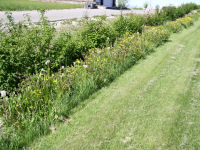
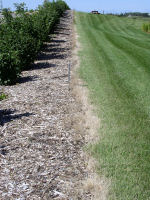
Here is a picture to give you an impression of our South side neighbour. The lawn is our yard. The dandelions are my neighbour's. (22-Jun-2005)
Funny thing is that two days after this picture was taken, the neighbours pulled out all the dandelions. After that there was a row of nine large, orange garbage bags lining their driveway for a while.
The weeds are now regularly controlled with heavy spraying with herbicides, which is liberally sprayed on our grass as well. Isn't it nice to have lovely neighbours. (20-Aug-2005)
Homepage |
Grand Tour |
Main Yard Details |
Flowerbed Details |
Yard Tips |
Wildlife |
Animal Terminology |
Other Web Sites